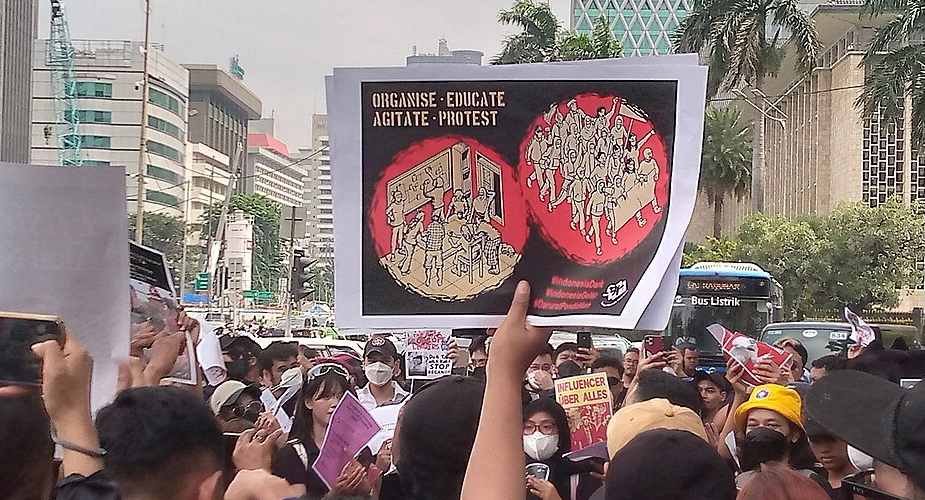Petrol subsidies have gone, but at what cost to Indonesia’s poor?
Iona Main
Indonesia’s contentious 2014 presidential election may now be a distant memory, but post-victory, Joko Widodo, or Jokowi, has moved swiftly to enact key policies. One such policy, the one on which he and rival candidate, Prabowo Subianto, could agree, is that Indonesia’s fuel subsidy scheme could not continue in its previous state.
Until recently, Indonesia’s decades-old fuel subsidy policy was so expensive that it almost defied belief. It consumed a staggering 20 per cent of total government expenditure in 2013. With that year’s total subsidy bill topping a cool A$21.1 billion, Indonesia’s treasury was forced to ‘borrow’ from the 2014 budget just to make ends meet. Indonesia has been a net oil importer since 2003, making the subsidy policy a difficult beast to control: whenever volatile world oil prices rose, the Indonesian government was forced to foot an increasingly pricey subsidy bill. Domestic fuel consumption in Indonesia has also been growing exponentially as the middle-class replace motorbikes with cars, and the sheer volumes involved meant even a small uptick in world oil prices could have spelt catastrophe for Indonesia’s best-laid budgetary plans.
There is no perfect moment to wrench away a benefit many Indonesians once regarded as a birthright. However, the declining oil prices of early 2015 brought about favourable conditions for managing the side effects of the subsidy cut, such as inflation. And one might say Jokowi has chosen a good time to make his move.
 Ibu Aam of Babakan Ciparay sub-district, Bandung - Mokstimofeevic
Ibu Aam of Babakan Ciparay sub-district, Bandung - Mokstimofeevic
There is a broadening public awareness in Indonesia that petrol subsidies have been an expensive and ineffective welfare measure. A subsidy’s benefits are primarily enjoyed by those who use it most, which in this case are wealthy private vehicle owners. Poor Indonesian families can rarely afford to own any kind of motorised transport, meaning they derive very limited benefit from subsidised petrol. In general, subsidies are a poor long-term policy tool, as they lead to distortions in the market, and in Indonesia’s case, they became a redundant form of middle-class welfare. Any advantages Indonesia’s economy may have ever reaped from cheap domestic petrol came to be outweighed by the enormous hole they made in the country’s national budget over the course of many years.
Winding back the subsidy scheme is much easier said than done. In 2014, PDIP economic advisor Sri Adiningsih proposed raising petrol prices by Rp.1500 (A$0.15) per litre per year to gradually wean Indonesians off the subsidy, but Jokowi has apparently favoured a more ruthless approach. Within weeks of his inauguration in November 2014, he instigated a small subsidy cut, and then abolished the scheme entirely as of 1 January 2015. Exceptions have been provided for diesel, which is still subsidised, for fuel used by public transport vehicles and the nation’s many fishermen.
Generally speaking, the main economic impact of petrol subsidy cuts is inflation, which spikes sharply as petrol prices increase. In the long run, inflation will readjust to normal levels, but the interim period can be acutely painful for poor families. Often, prices are revised upwards and never come back down. In Bandung, West Java, the fare for a minibus ride across town rose by up to 40 per cent after subsidy cuts in June 2013, despite the actual per-passenger cost of this service on a normal day having increased by less than 15 per cent. The social impact of subsidy cuts is also felt most heavily by the poor, who enjoyed little benefit from it to begin with and who may struggle to meet the cost of basic necessities. Almost no Indonesian household below the poverty line possesses savings, leaving these families with nowhere to turn. In the Babakan Ciparay sub-district of Bandung, anecdotal evidence suggests that many households dealt with higher prices by reducing already low levels of household consumption. One woman, Ibu Sita Aisa, now walks to the market in order to save the Rp.1000 fare and says many others do the same. For families already on the margins, these are heavy costs to bear.
 Children play with a hawker's stall in Babakan Ciparay sub-district, Bandung - Mokstimofeevic
Children play with a hawker's stall in Babakan Ciparay sub-district, Bandung - Mokstimofeevic
Past measures taken by the Indonesian government to soften the blow of petrol subsidy cuts on the country’s poorest citizens have met with dubious success. Former president Susilo Bambang Yudhoyono made several attempts to rein in subsidy spending by raising prices in 2005, 2008 and 2013. Each time, the subsidy cuts were accompanied by a compensation package, most recently known as the Unconditional Cash Transfer Program (BLSM), intended to lessen the impact on poor households. Early problems with the compensation program included poor management, the widespread misappropriation of funds and the inclusion of a large number of non-poor households on recipient lists. This latter problem is known as ‘inclusion error’ and in 2005, it fuelled public fury due to perceived inequity, as communities felt resentful of wealthier households who received compensation money.
By 2013, the pendulum had swung too far in the other direction, with independent Jakarta think-tank SMERU declaring ‘exclusion error’– the exclusion of legitimately poor households from recipient lists – to be too high. This issue is significant, as it illustrates one of the major challenges in providing social welfare payments in Indonesia – the administrative nightmare of ensuring accurate targeting and recipient lists. Sample studies from 2013 showed that a large number of poor families received no compensation whatsoever, but that this was largely due to inaccurate, out-of-date or non-existent household income data rather than the misappropriation of funds. While updating this information is a mammoth undertaking, its benefits would increase the effectiveness of the other social welfare programs Jokowi has instigated: the Indonesia Health Card, Indonesia Smart Card and Family Welfare Fund. These programs show Jokowi’s commitment to the country’s poor is more than just lip service, although the jury is still out on how successfully these programs are being implemented and what the next steps might be.
While feedback on the 2015 distribution of compensation payments is not yet clear, outcomes for households which were granted compensation in 2013 are likely to be a good indicator of what we can expect. Research by SMERU indicates that the poverty rate for households that received the BLSM payment actually decreased slightly after the subsidy cut, illustrating that the payment was effective in reducing the short-term impact on poor households. On the other hand, non-recipient households that live below the poverty line (namely those who were victims of ‘exclusion error’) suffered deeply. Realistically, there are a very small number of households that the BLSM payment allows to rise above the poverty line. However, it is still clear that the payment enables recipients to stave off the immediate negative income effects of the subsidy cut, and ensure their family’s wellbeing in the short run at least.
Whether or not poor Indonesians receive the BLSM payment, economists still predict that they will benefit most from subsidy cuts in the long run for two key reasons. First, the Indonesian government will have money to spend on more beneficial projects – in the order of Rp.200 trillion (A$20 billion) this year alone, according to Finance Minister, Bambang Brodjonerogo. In 2014, government spending on petrol subsidies was close to ten times that on healthcare, despite the fact that Indonesia still has one of the highest maternal mortality rates in Asia and struggles to care for a quickly growing population. With fuel subsidies almost entirely a thing of the past, Jokowi faces a genuine opportunity to invest in worthwhile policies and programs. Redirecting spending to projects such as healthcare, community infrastructure and education will deliver tangible and near-immediate benefits to the entire population, including those at the lower end of the wealth spectrum.
Secondly, the poor may reap long-term benefits because the subsidy cuts will better position Indonesia for future economic growth. Although Indonesia has been doing relatively well in this area, government and institutional inefficiencies have made Indonesia less competitive than its neighbours, so Indonesian growth is lower than it could be. The elimination of the petrol subsidy scheme will plug a sizeable hole in Indonesia’s national budget. Furthermore, if the savings are managed properly, the country’s economy has the potential to flourish. Subsidy cuts in the past have not been dramatic enough to noticeably change the course of Indonesia’s economic growth, but it is possible that this time will be different. A World Bank study has found that almost 80 per cent of the improvement in the incomes of poor households in 118 countries worldwide can be attributed to economic growth rather than the redistribution of incaomes (through cash payments, social welfare programs and the like). This doesn’t render targeted compensation programs redundant – it merely highlights that while they are important in reducing short-term welfare impacts on the poor, the economic long term is where the greatest progress in poverty reduction can be achieved.
Iona Main recently completed a Commerce/Arts degree at the University of Sydney, majoring in Economics, Indonesian Studies and International Business. She completed two semesters of study in Yogyakarta and Bandung as part of the ACICIS program in 2013 and wrote a thesis on the topic of petrol subsidy cuts and their impact on poverty in Indonesia.
Related Articles:
Defueling success, Written by Self Rumbewas: Inside Indonesia 107: Jan-Mar 2012












